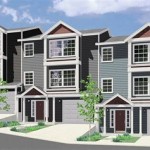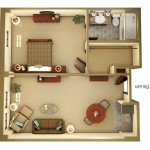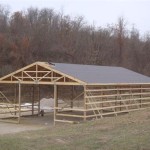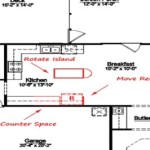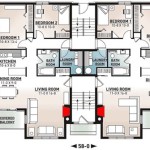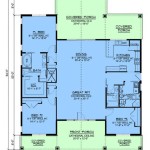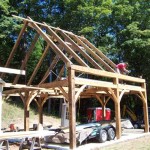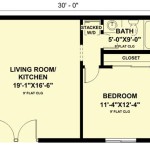```html
Smallest House Plans: Maximizing Space and Minimizing Footprint
Smallest house plans represent a growing trend in residential architecture, driven by factors like affordability, environmental consciousness, and a desire for simpler, more sustainable lifestyles. These plans focus on maximizing the utility of limited square footage, often incorporating innovative design strategies to create comfortable and functional living spaces within minimal footprints. The concept extends beyond mere downsizing; it necessitates careful consideration of every element, from spatial layout to material selection, to achieve optimal livability.
The appeal of smallest house plans is multifaceted. For first-time homebuyers or those seeking to downsize, the lower construction and maintenance costs are significant advantages. Reduced environmental impact stems from decreased material consumption, lower energy usage, and a smaller land footprint. Furthermore, a smaller living space often encourages a lifestyle centered around experiences and relationships rather than material possessions.
Key Considerations in Smallest House Plan Design
Developing successful smallest house plans requires a shift in perspective. Traditional notions of room size and separation need to be re-evaluated. Multifunctional spaces, efficient storage solutions, and strategic use of natural light are paramount. Several key considerations guide the design process:
Space Optimization: The cornerstone of any smallest house plan is the efficient use of space. This entails exploring open floor plans that combine living, dining, and kitchen areas. Vertical space becomes increasingly important, allowing for lofted bedrooms, storage solutions reaching the ceiling, and even compact home offices nestled above other areas. Furniture selection is also crucial; modular and convertible pieces that serve multiple purposes are ideal (e.g., a sofa bed, a dining table that folds down when not in use). Built-in storage, integrated into walls and under stairs, maximizes available space and minimizes clutter.
Natural Light and Ventilation: Adequate natural light and ventilation are essential for creating a comfortable and healthy living environment in a small space. Large windows and skylights can visually expand the interior and reduce the need for artificial lighting. Thoughtful window placement also promotes cross-ventilation, reducing reliance on air conditioning. Light-colored walls and ceilings reflect light and contribute to a brighter, more airy feel. Mirrors strategically placed can further enhance the illusion of spaciousness.
Multifunctional Design: Designing spaces that serve multiple functions is crucial. A dining table can double as a workspace, and a living room can transform into a guest bedroom with the help of a sofa bed. Modular furniture allows for easy reconfiguration to suit different needs. Even elements like kitchen islands can provide additional workspace, storage, and seating. The key is to think creatively about how a single space can be adapted to accommodate multiple activities throughout the day.
Common Smallest House Plan Layouts
While the specific layout depends on the size and shape of the house, certain patterns are common in smallest house plans. Understanding these patterns can help navigate the design process:
Open Concept Living: As mentioned previously, open concept living is frequently employed, eliminating walls between the living room, dining area, and kitchen. This creates a more spacious and airy feel. The absence of walls allows for greater flexibility in furniture placement and encourages interaction between occupants.
Loft Bedrooms: Loft bedrooms, accessible by a ladder or staircase, are a way to separate sleeping areas without significantly increasing the footprint of the house. The space beneath the loft can be used for storage, a home office, or a bathroom. Adequate headroom is crucial for comfort in a loft bedroom.
Compact Bathrooms: Bathrooms are often kept as compact as possible, utilizing space-saving fixtures like wall-mounted toilets, corner sinks, and shower stalls instead of bathtubs. Careful planning is essential to ensure functionality within the limited space.
Outdoor Living Spaces: Decks, patios, and porches can extend the living space of a small house. These outdoor areas provide opportunities for relaxation, entertaining, and connection with nature, compensating for the limited indoor square footage.
Benefits Beyond the Obvious
Beyond affordability and environmental responsibility, smallest house plans offer several additional benefits that contribute to an enhanced quality of life:
Reduced Maintenance: Smaller homes require less cleaning and maintenance, freeing up time for other activities. The reduced number of rooms and smaller square footage translate to less time spent on household chores.
Increased Connection: Smaller living spaces can foster closer relationships between occupants. With less physical separation, family members are more likely to interact and spend time together.
Financial Freedom: The lower cost of ownership associated with smallest house plans can lead to increased financial freedom. This can allow individuals to pursue hobbies, travel, or save for retirement.
Materials and Construction Considerations
The choice of materials and construction methods significantly impacts the cost, durability, and environmental footprint of a small house. Sustainable and locally sourced materials are often preferred.
Sustainable Materials: Bamboo, reclaimed wood, and recycled content materials are popular choices for eco-conscious small house construction. These materials reduce environmental impact and can add character to the design.
Efficient Insulation: Proper insulation is crucial for maintaining a comfortable indoor temperature and reducing energy consumption. High-performance insulation materials can minimize heat loss in the winter and heat gain in the summer.
Prefabricated Construction: Prefabricated construction methods can reduce construction time and costs. Modular homes, built in a factory and assembled on-site, are a viable option for those seeking a quicker and more efficient building process.
Challenges of Smallest House Plans
Despite their numerous advantages, smallest house plans also present certain challenges:
Storage Limitations: Limited storage space requires careful organization and decluttering. Regularly purging unnecessary items is essential for maintaining a functional living space.
Limited Privacy: Open floor plans can reduce privacy, especially in shared living areas. Strategic use of furniture and screens can help create more defined spaces.
Building Codes and Regulations: Some building codes may impose minimum size requirements for certain rooms or features. It's important to research local regulations before embarking on a small house project.
Resale Value: The resale value of a smallest house may be lower than that of a larger house in the same neighborhood. However, the growing popularity of small house living may increase demand in the future. The local market will determine its desirability.
Technology Integration in Smallest Houses
Technology plays a critical role in enhancing the functionality and comfort of smallest houses. Smart home devices and energy-efficient appliances can maximize space and minimize resource consumption.
Smart Home Automation: Smart home systems allow for remote control of lighting, temperature, and security, optimizing energy efficiency and convenience. Voice-controlled assistants can further simplify everyday tasks.
Compact Appliances: Compact appliances, such as smaller refrigerators, dishwashers, and laundry machines, save space without sacrificing functionality. Energy-efficient models can further reduce energy consumption.
Entertainment Systems: Wall-mounted TVs and sound systems can minimize clutter and provide entertainment without occupying valuable floor space. Streaming services offer access to a vast library of content without the need for physical media.
```
These Small House Plans Pack A Lot Of Punch Houseplans Blog Com

Small House Plans Simple Tiny Floor Monster

Tiny House Design Floor Plans

15 Budget Friendly Tiny House Plans For Maximum Space And Comfort

540 Best Small House Plans Ideas

Small House Plans Economical Floor

How To Create A Small House Floor Plan That Works For You

Small House Plans To Build Your Own Home

Small House Plans Simple Floor Cool

Small House Plan N Style Design With Photos Learn Everything Civil And Structural Engineering Platform

